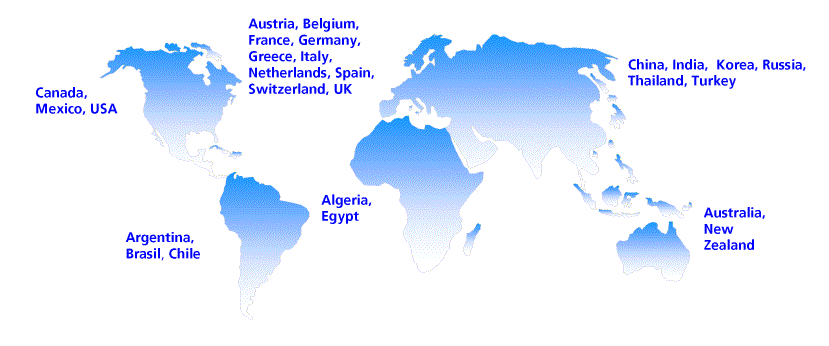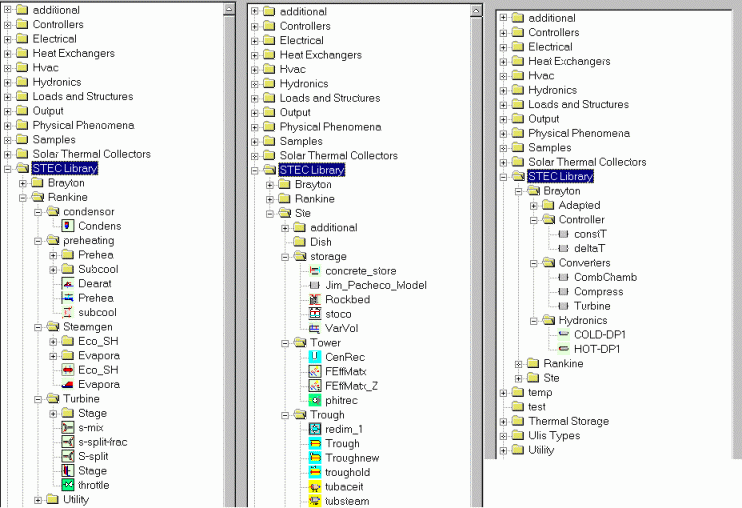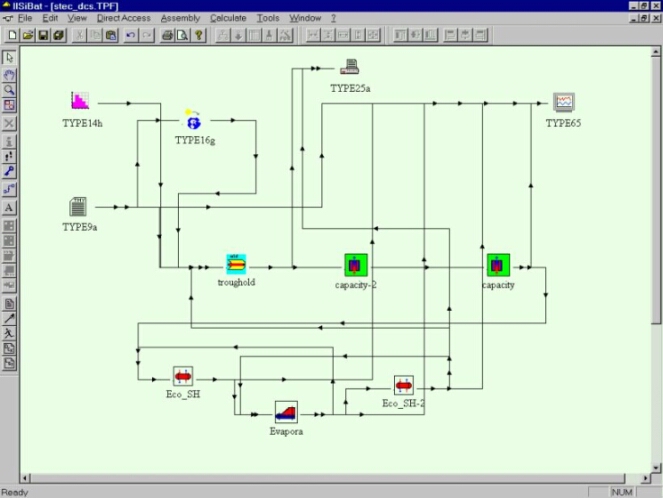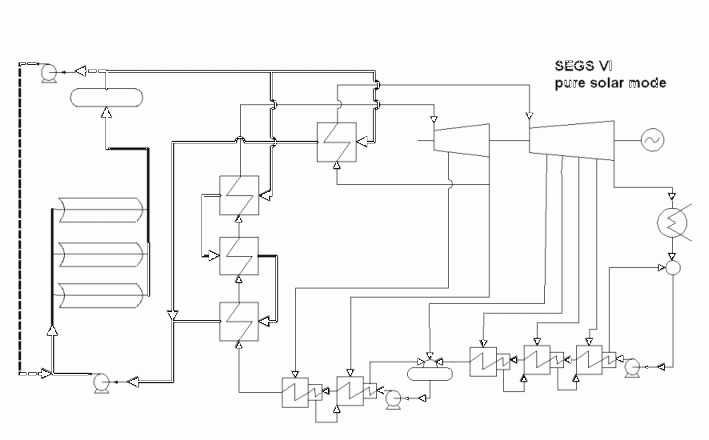


STEC
A TRNSYS Model Library for Solar Thermal
Electric
Components
new version 3.0 (for TRNSYS16) released November 2006 !!
HISTORY
SolarPACES
CONTENTS, DESCRIPTION, VALIDATION
HOW TO GET THE STEC MODEL LIBRARY
REFERENCES
WHAT IS STEC?
STEC is a collection of TRNSYS models especially developed to simulate solar thermal power generation. It is a supplement to the standard TRNSYS routines featuring components from solar thermal power plants like concentrating collectors, steam cycles, gas turbines and high temperature thermal storage systems. It was developed as a SolarPACES activity and is steadily used, updated and completed by users within the SolarPACES group. The STEC simulation models are intensively used in feasibility studies for solar thermal power projects as well as in research programmes for new solar thermal power technologies.
HISTORY
The STEC model library was initiated in 1998 in a joint effort by DLR (German Aerospace Centre) , Sun*Lab/SANDIA (USA) and IVTAN (Institut for High Temperatures of the Russian Academy of Science, Russia), three scientific organisations who are active in research and development of solar thermal power generation. TRNSYS and the STEC were envisioned as a potential replacement for the SOLERGY code, up to then the quasi-standard for estimating the annual performance of solar thermal power plants, which was no longer up to date with modern standards of computing power and user friendliness. SOLERGY is limited to energy flow calculations of fixed (hard wired) plant configurations. Consequently, various code adaptations arose for different plant designs and detailed modeling of plant thermodynamics was not possible. TRNSYS was chosen for the simulation environment because of its modularity, user friendliness and the simplicity in adding new component models. Moreover, the availability of the TRNSYS source code together with its reasonable price gave rise to hope for a rapidly increasing acceptance and usage of the STEC software developments.
In 2000 the STEC models were updated to be fully compatible with the new TRNSYS15 and Iisibat3. This work was mainly done by former TRNSYS engineer Nathan Blair, working under Prof. Beckman at the University of Wisconsin, Madison. In early 2001, parts of the STEC library were successfully validated with measurement data from the SEGS VI plant, a commercial solar thermal power plant in the Californian dessert. While agreement between the simulation and actual plant data was generally within 10%, there was difficulty in modeling solar field flow rate during transients. Later that year, Thorsten Stuetzle, Prof. Beckman and colleagues at the University of Wisconsin performed a ground-up analysis of the problem and developed a dynamic solar field model and new control algorithms that can both better model existing plant behavior and offer the possibility of more stable field outlet temperatures if implemented in place of human control. This work was initially performed in the EES simulation environment, but will be transferred to TRNSYS.
In September 2002 the completely revised version 2.2 of the STEC library was released containing a number of new models in the brayton, rankine and solar thermal subsection.
Today, the STEC library is distributed to more than 30 institutions world wide. The models are used in research and development as well as in commercial projects. One impulse of interest was the free distribution of the STEC library also to non-SolarPACES members in 2003. But lately, with numerous commercial solar thermal power projects emerging -mostly in Europe and the U.S.- the interest is even increasing and moving from public research to private business institutions.

STEC library users worldwide.
TRNSYS16 and the Simulation Studio were distributed in mid 2004 with significant changes especially in the model programming standard. Therefore a complete update of the source code model by model was necessary. This work was performed 2005/2006 with the great help of TRNSYS engineer Diego A. Arias.
The latest version 3.0 of the library was released in November 2006.
The status of the STEC model library is freeware with full access to the source code. This open status shall be maintained. The models are developed, written and tested by STEC-users. The distribution of the STEC library is a non-budget activity, currently conducted by DLR. Therefore, the library’s content and its quality is reliant on the contribution and collaboration of the single user. All recipients sign a user agreement and commit thermselves to improve the STEC library by adding own components or projects, by validating models with other codes or measurements or by giving comments and suggestions to the developers.
THE SolarPACES ORGANISATION
SolarPACES stands for Solar Power And Chemical Energy Systems and is a collaborative program of the International Energy Agency (IEA) focussing on development, research and demonstration of concentrating solar technologies.
The SolarPACES activities are subdivided into four tasks:
- Task I: Solar thermal electric power system
- Task II: Solar chemistry research
- Task III: Solar technologies and applications
- Task IV: Solar Heat for Industrial Processes (SHIP)
The SolarPACES Program is carried out under the framework of an Implementing Agreement, signed by contracting parties, which include government agencies and government-designated entities of the countries involved. There are currently 14 member countries in SolarPACES: Australia, Brazil, Egypt, European Commission, France, Germany, Israel, Mexico, Russia, South Africa, Spain, Switzerland, United Kingdom and United States.
For more information please visit the SolarPACES web-side.
CONTENTS, DESCRIPTION, VALIDATION
The STEC model library is subdivided into a Rankine section, a Solar Thermal Element (STE) section and a Brayton section. The Rankine section consists of various models to simulate a complete steam turbine cycle: Preheater, Economiser, Evaporator, Turbine, Condenser and several utility components like pumps, steam splitter, controller, etc. All these are zero capacitance models with quasi steady-state behaviour. A thermal capacitance model can be linked to include thermal 'inertia' to the system. The STE section contains models for concentrating solar technologies: A parabolic trough field model working with a one phase fluid. For solar power towers there is a central receiver model and a heliostat field model using a field efficiency matrix which can be derived from other computer codes for calculation of heliostat field layout (e.g. DELSOL). Additionally there are models for high temperature thermal storage systems like thermocline storage and concrete/oil storage. The Brayton section offers models to simulate in detail arbitrary gas turbine systems: compressor stage, combustion chamber, turbine stage, hydronic and control elements.

Screenshot of Iisibat3 TRNSYS model library structure with STEC components.

Screenshot of STEC example project assembly
All models are formulated to calculate the thermodynamic properties temperature, pressure, enthalpy, mass flow, power, etc. in standard TRNSYS units (°C, bar, kJ, kg/hr, kJ/hr,...) for compatibility with other standard and non-standard models.
In order to validate the developed models a comparison to measured data from a real operating solar thermal power plant was intended. Therefore a detailed performance model of the 30 MWe SEGS VI parabolic trough plant was created. Both solar and power cycle performance in solar only operation mode were modelled.
Model predictions showed generally good agreement with plant measurements with errors usually less than 10%. Transient effects such as startup, shutdown and cloud response were adequately modelled.

Arial view of the five SEGS plants at Kramer Junction in the Californian desert with a total generating capacity of 150 MW. (picture source: SANDIA)

Flow Diagram of the 30 MW SEGS VI plant for
pure solar mode
HOW TO GET THE STEC MODEL LIBRARY
> The complete STEC library including source code is provided free of charge and without technical support in version 16 format on request. Contact your TRNSYS distributor for more information.
REFERENCES
Schwarzboezl P.: A TRNSYS Model Library for Solar Thermal Electric Components (STEC). Reference Manual. Release 3.0, November 2006. (PDF)
Stoddard M.C., Faas S.E., Chiang C.J. and Dirks A.J., SOLERGY - A computer Code for Calculating the Annual Energy from Central Receiver Power Plants. SAND86-8060 Sandia National Laboratories, Livermore, CA, 1987.
Jones S.A., Blair N., Pitz-Paal R., Schwarzboezl P. and Cable B., TRNSYS Modeling of the SEGS VI Parabolic Trough Solar Electric Generating System. Forum 2001, Solar Energy: The Power to Choose (Proceedings of the ASME International Solar Energy Conference). April 21-25, 2001, Washington, DC. (PDF)
Stuetzle T., Blair N., Mitchell J.W., Beckman W.A., Automatic Control of a 30 MWe SEGS VI Parabolic Trough Plant, ISES 2001 Solar World Congress. (PDF)
Kolb G.J. and Hassani V. Performance Analysis of Thermocline Energy Storage proposed for the 1MW Saguaro Solar Trough Plant, Proceedings of ISEC2006, ASME International Solar Energy Conference, July 8-13, 2006, Denver (CO). (PDF)